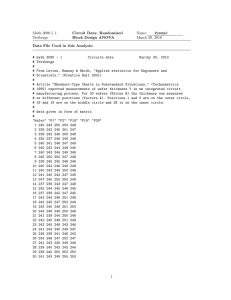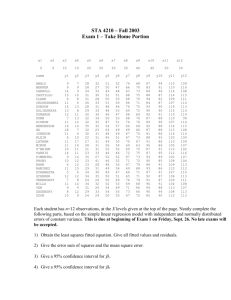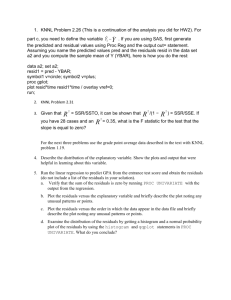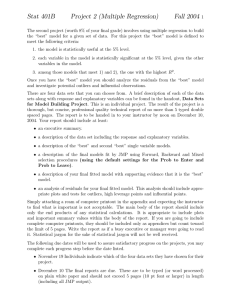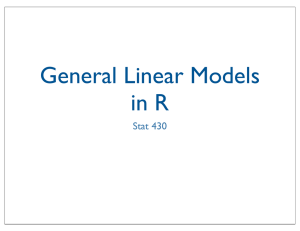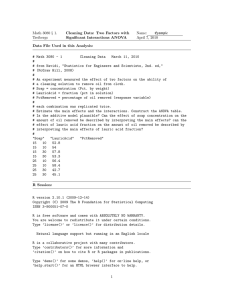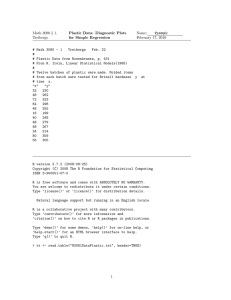Math 3080 § 1. Drilling Example: Name: Example
advertisement
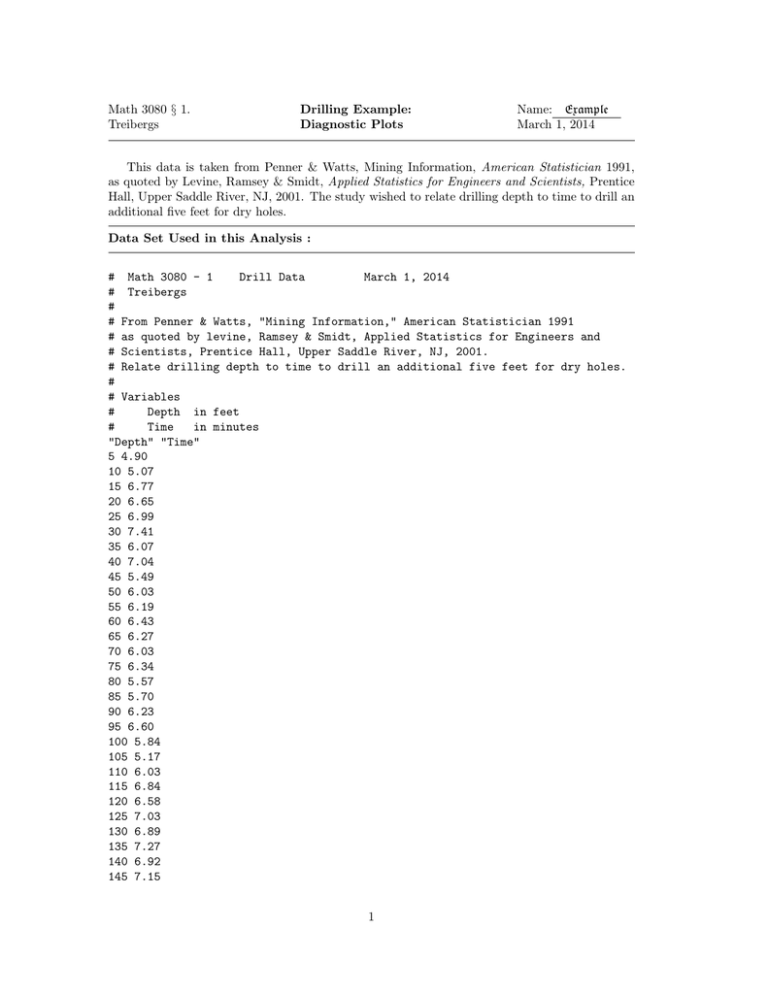
Math 3080 § 1. Treibergs Drilling Example: Diagnostic Plots Name: Example March 1, 2014 This data is taken from Penner & Watts, Mining Information, American Statistician 1991, as quoted by Levine, Ramsey & Smidt, Applied Statistics for Engineers and Scientists, Prentice Hall, Upper Saddle River, NJ, 2001. The study wished to relate drilling depth to time to drill an additional five feet for dry holes. Data Set Used in this Analysis : # Math 3080 - 1 Drill Data March 1, 2014 # Treibergs # # From Penner & Watts, "Mining Information," American Statistician 1991 # as quoted by levine, Ramsey & Smidt, Applied Statistics for Engineers and # Scientists, Prentice Hall, Upper Saddle River, NJ, 2001. # Relate drilling depth to time to drill an additional five feet for dry holes. # # Variables # Depth in feet # Time in minutes "Depth" "Time" 5 4.90 10 5.07 15 6.77 20 6.65 25 6.99 30 7.41 35 6.07 40 7.04 45 5.49 50 6.03 55 6.19 60 6.43 65 6.27 70 6.03 75 6.34 80 5.57 85 5.70 90 6.23 95 6.60 100 5.84 105 5.17 110 6.03 115 6.84 120 6.58 125 7.03 130 6.89 135 7.27 140 6.92 145 7.15 1 150 155 160 165 170 175 180 185 190 195 200 205 210 215 220 225 230 235 240 245 250 7.25 7.05 6.95 6.76 5.97 7.75 7.11 7.07 7.17 6.91 6.15 6.19 6.29 5.58 7.22 7.62 8.28 7.59 6.42 7.12 6.62 R Session: R version 2.10.1 (2009-12-14) Copyright (C) 2009 The R Foundation for Statistical Computing ISBN 3-900051-07-0 R is free software and comes with ABSOLUTELY NO WARRANTY. You are welcome to redistribute it under certain conditions. Type ’license()’ or ’licence()’ for distribution details. Natural language support but running in an English locale R is a collaborative project with many contributors. Type ’contributors()’ for more information and ’citation()’ on how to cite R or R packages in publications. Type ’demo()’ for some demos, ’help()’ for on-line help, or ’help.start()’ for an HTML browser interface to help. Type ’q()’ to quit R. [R.app GUI 1.31 (5538) powerpc-apple-darwin8.11.1] [Workspace restored from /Users/andrejstreibergs/.RData] > tt = read.table("M3082DataDrill.txt",header=T) > attach(tt) 2 > tt Depth 1 5 2 10 3 15 4 20 5 25 6 30 7 35 8 40 9 45 10 50 11 55 12 60 13 65 14 70 15 75 16 80 17 85 18 90 19 95 20 100 21 105 22 110 23 115 24 120 25 125 26 130 27 135 28 140 29 145 30 150 31 155 32 160 33 165 34 170 35 175 36 180 37 185 38 190 39 195 40 200 41 205 42 210 43 215 44 220 45 225 46 230 47 235 48 240 49 245 50 250 Time 4.90 5.07 6.77 6.65 6.99 7.41 6.07 7.04 5.49 6.03 6.19 6.43 6.27 6.03 6.34 5.57 5.70 6.23 6.60 5.84 5.17 6.03 6.84 6.58 7.03 6.89 7.27 6.92 7.15 7.25 7.05 6.95 6.76 5.97 7.75 7.11 7.07 7.17 6.91 6.15 6.19 6.29 5.58 7.22 7.62 8.28 7.59 6.42 7.12 6.62 3 > names(tt) [1] "Depth" "Time" > ############# SCATTERPLOT OF DATA WITH REGRESSION LINE ############ > plot(Time~Depth, main = "Scatter Plot of Drilling Depth v. Time to Drill next 5’") > f1 = lm(Time~Depth); abline(f1,col=2) > # M3082Drill1.pdf > > ############### PLOT STD. RESID. VS X ############################ > > plot(rstandard(f1)~Depth,ylab="Standardized Residuals of Time", main="Std. Resid. of Time vs. Depth",ylim=max(abs(rstandard(f1)))*c(-1,1)) > abline(h=c(0,2,-2),lty=c(5,2,2)) > > ############### PLOT STD. RESID. VS FITTED ####################### > > plot(rstandard(f1)~fitted(f1), ylab="Standardized Residuals of Time", xlab="Fitted Values",main="Std. Resid. of Time vs. Fitted Values", ylim=max(abs(rstandard(f1)))*c(-1,1)) > abline(h=c(0,2,-2),lty=c(5,2,2)) > > ############### PLOT FITTED VS OBSERVED ########################## > > plot(fitted(f1)~Time, ylab="Fitted values of Time", xlab = "Observed Time Values", main = "Fitted Values of Time vs. Observed Values of Time", xlim = c(mi,ma), ylim = c(mi,ma)) > > ############### NORMAL Q-Q PLOT OF STD. RESID.##################### > > qqnorm(rstandard(f1), ylab = "Standardized Residuals of Time", main = "QQ-Plot of Std. Resid. of Time", ylim = max(abs(rstandard(f1)))*c(-1,1)) > abline(h=c(0,2,-2), lty=c(5,2,2)); abline(0,1,col=2) > > ########### PLOT STANDARDIZED RESIDUALS VS INDEX: DATA ORDER ###### > > plot(rstandard(f1), ylab = "Standardized Residuals of Time", xlab = "i = order of observation", main = "Std. Resid. of Time vs. i = Order of Observation", ylim = max(abs(rstandard(f1)))*c(-1,1)) > abline(h=c(0,2,-2),lty=c(5,2,2)) > > ################# CANNED DIAGNOSTIC PLOTS ######################### > > layout(matrix(c(1,3,2,4),nrow=2)) > plot(f1) > # M3082Drill7.pdf 4 > ################### SUMMARY AND ANOVA TABLE FOR REGRESSION > > summary(f1); anova(f1) ###### Call: lm(formula = Time ~ Depth) Residuals: Min 1Q -1.38156 -0.58099 Median 0.03983 3Q 0.44131 Max 1.27335 Coefficients: Estimate Std. Error t value Pr(>|t|) (Intercept) 6.002882 0.186050 32.265 < 2e-16 *** Depth 0.004459 0.001270 3.511 0.000982 *** --Signif. codes: 0 *** 0.001 ** 0.01 * 0.05 . 0.1 1 Residual standard error: 0.6479 on 48 degrees of freedom Multiple R-squared: 0.2043,Adjusted R-squared: 0.1878 F-statistic: 12.33 on 1 and 48 DF, p-value: 0.0009821 Analysis of Variance Table Response: Time Df Sum Sq Mean Sq F value Pr(>F) Depth 1 5.1756 5.1756 12.328 0.0009821 *** Residuals 48 20.1520 0.4198 --Signif. codes: 0 *** 0.001 ** 0.01 * 0.05 . 0.1 1 > > ############## SHAPIRO WILK TEST FOR NORMALITY ################### > > shapiro.test(rstandard(f1)) Shapiro-Wilk normality test data: rstandard(f1) W = 0.977, p-value = 0.4323 > > > 5 6.5 6.0 5.5 5.0 Time 7.0 7.5 8.0 Scatter Plot of Drilling Depth v. Time to Drill next 5' 0 50 100 150 Depth 6 200 250 1 0 -1 -2 Standardized Residuals of Time 2 Std. Resid. of Time vs. Depth 0 50 100 150 Depth 7 200 250 1 0 -1 -2 Standardized Residuals of Time 2 Std. Resid. of Time vs. Fitted Values 6.0 6.2 6.4 6.6 Fitted Values 8 6.8 7.0 7.0 6.5 6.0 5.5 5.0 Fitted values of Time 7.5 8.0 Fitted Values of Time vs. Observed Values of Time 5.0 5.5 6.0 6.5 7.0 Observed Time Values 9 7.5 8.0 1 0 -1 -2 Standardized Residuals of Time 2 QQ-Plot of Std. Resid. of Time -2 -1 0 Theoretical Quantiles 10 1 2 1 0 -1 -2 Standardized Residuals of Time 2 Std. Resid. of Time vs. i = Order of Observation 0 10 20 30 i = order of observation 11 40 50 Normal Q-Q 6.2 6.4 6.6 6.8 1 0 -2 43 -1 Standardized residuals 0.5 -0.5 21 6.0 6 2 6 -1.5 Residuals 1.5 Residuals vs Fitted 7.0 43 -2 Fitted values 2 1 0 -1 Standardized residuals 2 46 1 -2 1.5 1.0 Standardized residuals 21 6.4 1 Residuals vs Leverage 0.5 6.2 0 43 Cook's distance 0.0 6.0 -1 Theoretical Quantiles Scale-Location 6 21 6.6 6.8 7.0 0.00 Fitted values 0.02 0.04 Leverage 12 43 0.06 0.08
